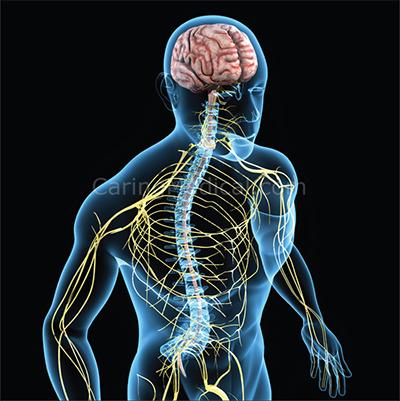 The nervous system is defined as “the system of nerves in your body that sends messages for controlling movement and feeling between the brain and the other parts of the body.” The Autonomic Nervous system is comprised of the sympathetic and parasympathetic nervous systems. You are driving over the Causeway with the windows down, the breeze blowing, Jimmy Buffett playing, the pelicans flying alongside you – it’s your happy place. Suddenly a vehicle coming from the opposite direction drifts into your lane. To avoid a collision, you swerve toward the shoulder nearly hitting a bicyclist, but you quickly correct and get back into your lane without hitting the oncoming vehicle or the bicyclist. Fortunately, everyone is safe. Despite knowing you are safe, your heart rapidly pounds against your chest and your clammy hands attempt to continue driving. Your mind is racing and now you are on high alert, where moments ago you were chillin’.
The nervous system is defined as “the system of nerves in your body that sends messages for controlling movement and feeling between the brain and the other parts of the body.” The Autonomic Nervous system is comprised of the sympathetic and parasympathetic nervous systems. You are driving over the Causeway with the windows down, the breeze blowing, Jimmy Buffett playing, the pelicans flying alongside you – it’s your happy place. Suddenly a vehicle coming from the opposite direction drifts into your lane. To avoid a collision, you swerve toward the shoulder nearly hitting a bicyclist, but you quickly correct and get back into your lane without hitting the oncoming vehicle or the bicyclist. Fortunately, everyone is safe. Despite knowing you are safe, your heart rapidly pounds against your chest and your clammy hands attempt to continue driving. Your mind is racing and now you are on high alert, where moments ago you were chillin’.
This scenario demonstrates the sympathetic and parasympathetic nervous systems in action. They are continuously producing responses, balancing each other out. But many external stimuli can tip create an imbalance, tipping the scale in one direction or another.
The autonomic (occurs automatically) nervous system controls involuntary physiological responses, such as heart rate, contraction/relaxation of blood vessels, stomach, and intestines. The sympathetic nervous system is responsible for generating the physiological responses that occur from stressful or dangerous situations, commonly referred to as “fight or flight” – as in the situation described above. The parasympathetic nervous system produces physiological responses that occur at rest and is often referred to as the rest and digest state. They are essentially opposite of one another.
In our center, we see many patients with a myriad of mysterious and simultaneous conditions and symptoms that affect the nervous system. They unload a shopping bag full of medications that they are taking for all of their symptoms – none of which have helped them resolve the symptoms – along with a long list of diagnoses they have accumulated over the years. Many of these patients have what is termed dysautonomia, meaning their nerves are not communicating correctly. These symptoms can manifest themselves as problems with blood pressure and heart rate. Some also have EDS (Ehlers-Danlos-Syndrome) or Lyme Disease. Others will report that they pass out for no reason or that their heart starts beating uncontrollably, food gets stuck in their throat, their mouth burns, digestion is abnormal, and they have headaches, migraines, and fatigue.
What is the cause? From our research, we have found that these problems may arise from an underlying cervical (neck) or lumbar (back) spinal instability leading to autonomic nervous system dysfunction. The autonomic ganglion is a cluster of nerve cell bodies. Their job is to send sensation signals to the central nervous system. The autonomic ganglia pass and run very close to the vertebrae of the spinal column. When the vertebrae have unstable movement, they can press on nerves, stretch out nerves, compress the autonomic ganglion. Thus, people may experience problems with vision, heart function, digestion, bladder function, temperature regulation, and a wide array of other symptoms. Dynamic Autonomic Nervous System testing (such as the protocols we have at Caring Medical) can be performed to document why the nervous system is not functioning properly. Understanding the structural breakdown in the spine and its repair using Prolotherapy and Dynamic Curve Correction can be life-changing. Addressing emotional and stress-related aspects of life will also help keep the nervous system functioning properly. Do not give up – there is hope for these seemingly crazy symptoms.



